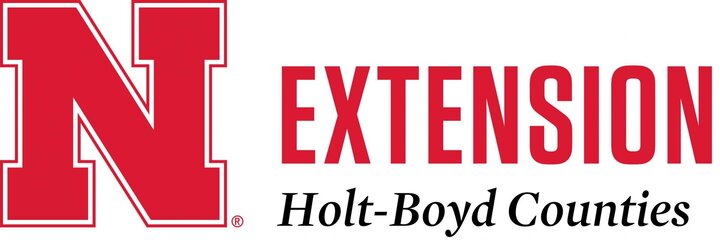
Nebraska Extension Educator - Holt/Boyd Counties - LaDonna Werth
Nebraska Extension Educator - Holt/Boyd Counties - Amy Timmerman
Nebraska Extension Educator - Brown/Rock/Keya Paha Counties - Brittany Spieker
Nebraska Extension Educator - Holt/Boyd/Garfield/Loup/Wheeler Counties - Bethany Johnston
Nebraska 4-H Assistant - Holt/Boyd Counties - Debra Walnofer
June 1: DUE: State 4-H Horse Expo Online Entries and Horse I.D.s submitted to extension office https://4h.unl.edu/statewide-events-opportunities/horse-program/horse-expo/show-entry/
June 2: SB & Air Pistol Practice, Holt County Fairgrounds, Chambers, NE, https://www.signupgenius.com/go/10C0F4DADAD2DA6FACF8-57126837-sbair#/
June 2: .22 Rifle Practice, Holt County Fairgrounds, Chambers, NE, https://www.signupgenius.com/go/10C0F4DADAD2DA6FACF8-57126819-22rifle#/
June 3: Face-to-Face YQCA Training, 9am, Holt County Annex, O’Neill, NE, https://yqcaprogram.org/login/index.php
June 4: ServSafe Food Handlers Training, 8:30am-12:30pm, Holt County Annex Meeting Room
June 5: Workshop to Address the Spread of Cedar Trees and Control Options, 1:00–4:30pm, Holt County Courthouse Annex, O’Neill, NE
June 5: Drought Management for Beef Producers, 7:30-9:00pm, Holt County Courthouse Annex, O’Neill, NE with Webinar option
June 7: Holt County 4-H Shooting Sports Invitational, 8:00am, Holt County Fair Grounds, Chambers Nebraska
June 11-12: Tractor and Equipment Safety Training, AKRS Equipment Solutions, Inc, register at go.unmc.edu/tractor-safety-training
June 11: Young Rancher Workshop - Nebraska Grazing Lands Coalition and Ranch Management Consultants - Burwell, Nebraska, Contact Leah Peterson: director@nebraskagrazinglands.org, 308-872-1250
June 13: 4-H Rabbit Tattooing, 9:00am-4:30pm, Holt County Extension Office, O’Neill, NE
June 15: DUE: ALL Other Clover Kid, 4-H and FFA Animal ID Sheets, Holt County Extension Office, O’Neill, NE
June 15: DUE: Nebraska 4-H Enrollment Deadline
Managing a Home When Everyone Works
We all work hard today! With commuting and demands of the job, nobody has time or energy for housework. Many couples who share a home have a hard time sharing the tasks required to keep a home running smoothly. Many parents aren’t sure what chores are appropriate for children or how to get children to help out around the house.
Children benefit from helping with household chores. They learn responsibility and work habits. However, it is also important for kids to have plenty of time to be kids. If children have excessive household responsibilities, they don’t have time to play and spend time with friends. These activities may not seem as important as chores, but playtime actually helps children develop their talents and learn important skills, such as self-direction and how to interact with others. The key is to give children age-appropriate tasks that do not interfere too much with their other activities.
Getting everyone to help with household chores can be a challenge. Having a family meeting can help. Schedule a meeting with all of those who can take responsibility for tasks. Decide what tasks must be done and how often they have to be accomplished. Decide who can do which jobs. Be sure to allow each family member to have input and listen to each person’s ideas. Some families make a chart to rotate jobs. Some family members have favorite jobs. Many jobs have required standards – use this as an opportunity to teach quality control. A large calendar is an easy way to track who has responsibility for what. After trying out the plan for a week or two, have another family meeting to talk about how well it is working. Make any changes that are needed at that time.
LaDonna Werth
Extension Educator
Phone: 402-336-2760
E-mail: lwerth2@unl.edu

Some household tasks can be done as a family activity, which can help create a sense of closeness. Children can help sort unused clothing and toys for a family fund raiser or yard sale. Perhaps the proceeds can be used for family fun. These activities might even become new family traditions. Working together as a family to accomplish household tasks helps everything get done, creates a sense of family togetherness, and teaches children responsibility.
Source: Jinny Hopp, former human development specialist, Jasper County, University of Missouri Extension
Planting Summer Annuals
Now is the time to plant summer annuals, especially due to welcome rains. Summer annuals are typically warm-season grasses planted in western Nebraska prior to June 1 to provide grazing or harvested as feed for beef cattle.
Warm-season species such as sudangrass, sorghum-sudangrass, teff, pearl millet, foxtail millet and forage sorghum (also named cane, sorgo or “feed sorghum”) can complement cool-season plants.
Cool-season forages peak their production in May and early June when summer temperatures rise, while summer annuals peak their production in July and August. So how do producers know which species among the seven types to plant? The answer depends upon their intended usage.
For example, if producers desire to extend their pastures due to drought, then sudangrass or pearl millet might be good choices. Both grow rapidly and have high leaf to stem ratios, along with less fall grazing risk for prussic acid poisoning.
If producers are wanting more hay or green chop production, then sorghum-sudan hybrids or pearl millets might provide good yields when cut two or three times. On sandy soils, foxtail millet might be better for summer hay production, since it dries fast and does not regrow after cutting to preserve moisture for subsequent crops. Conversely, Japanese millet can tolerate wet soils and be cut for hay or grazing.
Amy Timmerman
Extension Educator
Phone: 402-336-2760
E-mail: atimmerman2@unl.edu

Cane hay has traditionally been grown for high tonnage, but it usually has lower feed value and dries slower than hybrid sorghums and millets. Teff provides excellent quality as a soft, leafy forage - especially appealing for horses - but is lower tonnage compared to other summer annuals.
Nebraska Extension on-ranch forage research launched in 2024 near Arthur, Mullen, Hyannis, Thedford and Valentine is comparing irrigated summer annuals such as forage corn, Group 5 forage soybeans, hybrid sweet sorghums, silage mixes, hybrid pearl millet and brown mid-rib forages. More information will be shared during UNL at-location field tours during the first week of August.
More information regarding planting summer annuals is available on CropWatch.
Source: Todd Witney - UNL Irrigation and Cropping Systems Extension Educator
Horn Flies and Grazing Cattle
The horn fly is one of the most damaging pests of pasture and rangeland cattle across the U.S. Adult horn flies are blood-feeding insects that take an average of 30 blood meals per day. Their populations can build rapidly and often exceed the Economic Injury Level (EIL) defined as 200 flies per animal. Once fly numbers surpass this threshold, cattle experience reduced weight gain and milk production due to fly-induced stress and altered grazing behavior.
Observing your cattle during summer months is key to detecting fly pressure. Are they constantly tossing their heads, swishing their tails, or twitching their skin? These are clear signs of fly irritation and an indication that a more effective control strategy may be needed.
In the U.S. alone, cattle producers lose over $1 billion annually due to horn fly infestations. With fly season approaching, now is the time to evaluate and refine your horn fly management plan for 2025. If your 2024 control efforts underperformed, consider adjusting your approach. The best control method will depend on several factors including efficacy, cost, convenience, and your current herd management practices.
It’s also important to remember that horn flies can migrate from neighboring untreated herds, masking the effectiveness of your efforts and increasing fly pressure. For this reason, a comprehensive, integrated fly control program is recommended. Such a program may include:
Bethany Johnston
Extension Educator
Phone: 402-336-2760
E-mail: bjohnston3@unl.edu

1. Insecticide Ear Tags
- Cattle should receive the number of tags recommended on the product label.
- Tagging just the calf, and not the cow, will not provide the desired level of control.
- Rotate active ingredients each year to help manage resistance.
- For maximum effect, apply tags in late May or early June and remove them in the fall.
2. Pour-ons and Sprays
- Flexible and useful for rapid knockdown.
- May require reapplication every 2-3 weeks.
- Mist blower sprayers and automatic sprayers can reduce labor and improve application efficiency.
3. Feed-through Products (IGRs)
- Work by disrupting the horn fly life cycle in manure.
- It should be in use 30 days before the start of fly season.
- Most effective in closed herds with consistent intake.
- Less effective when nearby cattle remain untreated.
4. Dust bags
- Bags should be located, so cattle must pass under them.
- Studies have shown that bags not forced-used, provide 25 to 50% less control.
- One dusting location with two bags treats approximately 50 to 60 cows.
5. Back rubbers and Oilers
- More effective when placed in a force-use arrangement.
- Do not use motor oil to dilute the insecticide; this will harm cattle.
6. Compressed Air Application
- Applies an individual capsule of insecticide (VetCap) to an animal, providing between 10 to 35 days of control.
- VetCaps can be used on cattle weighing at least 600 lbs.
7. Natural Products - Garlic
- It has been theorized that the strong odors emitted from the skin of animals fed garlic-based products are due to volatile organosulfur compounds formed during the metabolism of garlic. These metabolites, such as diallyl disulfide and allyl methyl sulfide, are absorbed into the bloodstream and transported throughout the body, eventually being excreted through the skin and breath. The presence of these pungent sulfurous compounds on the skin surface is thought to act as a natural repellent, deterring biting flies from landing or taking a blood meal (Maia and Moore, 2011).
- Commercial products normally contain a 2% concentration of garlic powder.
8. Mechanical Control – Bruce Walk-through Fly Trap
- Best placed in a forced-use situation, where cattle must pass through on a regular basis.
- Requires a period of animal acclimation.
- For blueprints, contact me at dboxler1@unl.edu or 308-696-6721.
Managing Insecticide Resistance in Pasture Fly Control
No matter which livestock fly control product or application method you use, it's important to plan for insecticide resistance. Over time, repeated use of the same type of insecticide can lead to reduced effectiveness as flies develop resistance. A key strategy to manage resistance is rotating products based on their Mode of Action (MoA).
The Insecticide Resistance Action Committee (IRAC) classifies insecticides into groups based on how they affect the target pest’s biology. These IRAC MoA group numbers help producers choose products that kill insects in different ways. Always check the “Insecticide Resistance Management” section on the product label—it lists the IRAC group number and its mode of action.
Example:
- Permectrin II and Cylence Ultra are Group 3A insecticides – they disrupt nerve function by acting on sodium channels.
- Co-Ral Fly and Tick Spray and Prolate/Lintox HD belong to Group 1B – they inhibit acetylcholinesterase, an enzyme critical for nerve signal transmission.
Best Practices for Resistance Management
- Rotate between insecticide MoA groups each fly season, and if possible, within the season.
- Avoid repeated use of insecticides from the same MoA group.
- Choose products with different MoAs for back-to-back treatments or when switching application methods (e.g., ear tags vs sprays).
- Always follow label directions and use the recommended dose to ensure effective control and avoid under-dosing, which can accelerate resistance.
Implementing an insecticide rotation strategy not only helps extend the life of available products but also improves fly control, enhances animal welfare, and protects your bottom line.
Source: Dave Boxler - Nebraska Extension Educator (May 1, 2025)
NEWS RELEASE
WORKSHOP TO ADDRESS THE SPREAD OF CEDAR TREES AND CONTROL OPTIONS
Cedar trees are rapidly spreading across Nebraska’s grasslands, threatening valuable forage for grazing animals and habitat for wildlife. In some areas, grass production has dropped by as much as 75% over the past three decades due to cedar tree encroachment. The best time to control your cedar trees is now!
To help landowners and producers tackle this issue, a hands-on workshop will be held on Thursday, June 5, from 1:00 to 4:30pm CT at the Holt County Annex Building, located at 128 N 6th Street, O’Neill.
Gain insight from real-life examples of various cedar control projects, including before/after photos, cost of the projects, cost-share options, and how producers are maintaining cedar-free pastures to maximize grass. Understanding how cedar trees spread, and grow will help producers decide the best control options to use. Learn how to keep your prescribed burn contained to the unit - as slope, tree height, piles, weather, crew/equipment can be mitigated to ensure a safe and controlled burn. A member from the Prescribed Burn Association will share firsthand experiences and practical advice from their prescribed burns.
Walk-ins are welcome, but registrations are appreciated. Call the Holt County Extension Office at 402-336-2760 or email Bethany at mailto:bjohnston3@unl.edu.
Thanks to these partners: Nebraska Extension, Pheasant Forever, the Nature Conservancy, Sandhills Task Force, Nebraska Game & Parks, US Fish and Wildlife, and NRCS

NEWS RELEASE
Nebraska Extension to Host June 5 Webinar on Drought Management for Beef Producers
LINCOLN, Neb. - As drought conditions continue to affect much of Nebraska, beef producers are being forced to make difficult herd and forage management decisions. To support producers navigating these challenges, Nebraska Extension will host a free webinar on Thursday, June 5, from 6:30 to 8 p.m. Mountain Time / 7:30 to 9 p.m. Central Time.
The webinar, “Drought Management Tools, Expected Grass Production and Early Weaning,” will feature University of Nebraska–Lincoln specialists covering key management practices and decision-making strategies to help mitigate the effects of drought.
Scheduled topics and speakers include:
- Early weaning calves – Karla Wilke, cow-calf management specialist
- New drought planning tools – Tonya Haigh, National Drought Mitigation Center
- Range and pasture outlook – Mitch Stephenson, range and forage specialist
- Summer annual forage options – Jerry Volesky, range and forage specialist
“This webinar is designed to provide actionable information to help producers make sound, timely decisions during drought,” said Aaron Berger, Nebraska Extension beef educator.
“Whether you’re looking at forage alternatives or considering early weaning, this session will provide practical guidance.”
Producers may attend virtually or join one of several in-person host site locations across Nebraska:
- Rushville – Brock Ortner, Sheridan County Extension Office, 800 S. Loofborrow St.; 308-327-2312
- Scottsbluff – Mitch Stephenson, PREC Bluestem Room, 4502 Ave. I; 308-632-1355
- Kimball – Aaron Berger, Kimball Extension Office, 209 E. Third St.; 308-235-3122
- O’Neill – Bethany Johnston, Holt County Annex, 128 N. Sixth St.; 402-336-2760
- Fullerton – Josie Crouch, Nance County Extension, 304 Third St.; 308-536-2691
- Lexington – Talon Mues and Brent Plugge Dawson County Office, 1002 Plum Creek Pkwy; 308-324-5501
There is no cost to attend, but producers are encouraged to contact the host site ahead of time to help with planning.
To attend remotely via Zoom, contact Aaron Berger at aberger2@unl.edu to register and receive login details.
A recording of the webinar will be made available following the event for those unable to attend live.
For more information, contact Berger at 308-235-3122.